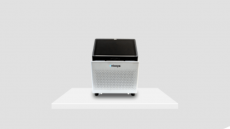Pfizer turns to Charles Stark Draper Laboratory for 'organ-on-a-chip' tech

Draper’s Biomedical Solutions office in Cambridge, Mass., will work alongside Pfizer on the new MPS systems, commonly also known as ‘organs-on-chips’.
Using microfluidic technology, organs-on-chips contain cells that imitate organ systems, which researchers say will radically change how drug development is managed in the industry.
Joseph Charest, Head of Draper’s Human Organ Initiative told Outsourcing-Pharma the partnership will develop three new MPS systems, to mimic gastrointestinal, liver and vascular organ systems, to improve translation of novel drug candidates into clinic.
The not-for-profit spin out from MIT claims its MPS technology can collect higher quality and more types of data compared to animal testing, with use of fewer materials and reduced cost.
Charest added that while the focus will be small molecule drugs, the technology could potentially be used for biologicals too with Draper having “near term plans for protein/antibody-based therapeutics.”
John Burkhardt, Vice President, Drug Safety Research & Development, at Pfizer told us the firm “plans to use [its] research efforts to help Pfizer to more effectively discover and develop new treatments,” and “although mostly staffed with Draper scientists, [the project] will be a partnership with Pfizer scientists as well.”
Cost and Risk
Charest told Outsourcing-Pharma that Draper’s MPS high throughput PREDICT96 platform can be customised to have multiple wells lined of a specific tissue model.
The platform is run in an incubators using microsensors to collect data in real-time.
Such technology enables rapid predictive modelling of how new drug candidates might behave in vivo.
Charest said the tech creates “the optimal environment for cell function. Our sensing technology measures the function of the cells directly and in real-time while our format ensures the system will scale to high levels of throughput,” in a statement.
The project is currently developing the platform and working on generating a functional single well tissue model for a human kidney.
Charest added “As we launch the program with Pfizer, we will further develop the platform, add functionality and demonstrate these three additional tissue models.”
PREDICT96 provides independent control of many parameters to guide growth of cells into functional tissues, the firm explained. “The challenge is to optimize those parameters for each specific tissue model while allowing each model to be run on the same platform.”
The team also needs to find test cases and tool compounds to validate the tissue models.
Translation to clinic and Animal testing
Around 70 – 90% of novel drug targets fail in clinical development, despite comprehensive in vivo and in vitro clinical testing. So there is a great industry need to de-risk drug discovery.
Chas Bountra, Professor at Oxford University and former head of Biology at GSK, explained that this was because “Target validation only happens in humans - not cell lines or animal models,” at Pharma Integrates in London last month.
This is what new technologies, like organs-on-chips, are working on improving, Bountra emphasising “we need to move away from animal models.”
For example, Draper claims using MPS, researchers can observe neutrophils penetrate cells and tissues in real-time, indicative of an inflammatory response. Animal testing cannot show this.
Pfizer’s Burkhardt told Outsourcing-Pharma “Finding a more efficient way to bridge the translation gap would enable us to humanize the drug discovery process and reduce dependence on other two-dimensional models.”
Big Pharma and Organs-on-Chips
Burkhardt added “Small molecules will certainly be an early focus because of the inherent challenges of balancing efficacy and safety with these entities. [Later] we may consider additional applications.”
Other large pharmaceutical firms have therefore expressed interest in organs-on-chips biotechs, as an alternative to animal models for ADMET testing.
For example, Merck & Co. also expanded a partnership with Organs on chips biotech Emulate earlier this year.
The Big Pharma firm, known as MSD in the US, is using Cambridge Mass. spin-out Emulate’s lung and gastrointestinal organs-on-chips to model responses in inflammatory diseases.
Charest told us “Draper will develop the technology [with Pfizer] until it is ready for commercialization, then the technology will be licensed either to a major partner or a for-profit spin-out.”























